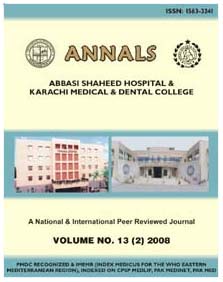
| |
| Home |
| Editorial Staff |
| Instruction to Authors |
| Journal-Issues |
| Policy |
| Copyright |
| COMPLICATIONS OF COLOSTOMY IN ABBASI SHAHEED HOSPITAL
*S. M. ABBAS HUSSAIN, RIZWAN A. KHAN, M. JAMALUDDIN, TANVEER ALAM ABSTRACT Objective: To describe the different complications of colostomy that developed after its construction either in emergency or elective surgery in Abbasi Shaheed Hospital Karachi. Subjects & Methods: Descriptive study from January 2006 to Dec. 2007 during which fifty patients who were above 12 years of age were admitted in Surgical Unit-I, of Abbasi Shaheed Hospital, Karachi, through emergency and out patient department. Information of patients including history, clinical examination, investigations, and indication of surgery, operative procedure and operative findings were collected. Gut preparation was done in elective cases only. Detail about stoma, its type, complications and treatment were observed carefully. Emergency colostomies were performed in emergency theatre while elective cases were done in main theatre. Patients were followed up from the construction of colostomy to the fourth post operative week to analyze the complications associated with stoma formation. Reversal of colostomy was done after 8th to 12th post operative period. Result: Among them 40 patients 80% were males and 20% were females. Students, labors and old age were mostly affected class. Most of them were victims of terrorism. Intestinal trauma due to gun shots and stab were the leading cause while the intestinal pathology like tuberculosis, carcinoma, volvulus, intestinal obstruction were found to be the less common causes of stoma formation. 40 patients (80%) were operated in emergency theatre while 10 patients (20%) under went elective faecal diversion. Majority of Colostomies were temporary loop colostomies, formed only for diversion and decompression of distal segment. Out of fifty patients, none of the patients had any major post operative complications like necrosis, prolapsed, parastomal hernia and fistula formations. Only twelve patients (24%) developed complications. Abdominal wall infection in two patients (4%) and skin excoriation in 3 patients (6%) around the stoma were found the commonest local complications. Retraction in 2 patients (4%), stenosis in two patients (4%) with stoma obstruction in 1 (2%) and detachment in 1 (2%) were found. All these cases required refashioning of Colostomy. Stoma bleeding and pain was also observed and treated in 2 patients (4%). The psychological trauma of having colostomy with a bag on the belly was a considerable problem which patient had during the period, which was reduced and post operative counseling and training was given. Conclusion: Stoma surgery has a wide range of clinical implication. It is relatively a save procedure either to reduce leakage of distal colonic repair or to provide sufficient time for the healing of intraperitonial trauma. The complications occurred in only 24% patients among which skin excoriation and skin infection occured in a few patients. Having an artificial anus was a mental torture for patients. Key Words: Colostomy, Temporary, Permanent, Stoma.
|
For Full text contact to:
|
|
Surgery Unit-1 Karachi Medical & Dental College, Abbasi Shaheed Hospital
|

Copyright © 2009 Abbbas Shaheed Hospital and Karachi Medical & Dental College.
All rights reserved.
Designed & Developed by: Creative Designers